Why Is My Jade Plant Losing Leaves? Crassula ovata is the scientific name for the Jade plant according to the University of Berkeley.
Succulent houseplants are among the most popular.
They have thick oval-shaped leaves and thick woody stems. They are long-living plants and can grow up to 3 ft. indoors.
But they require proper care, and they grow well in acidic soil with a pH of around 6. They need well-drained soil, a potting mix of coarse sand, and perlite or pumice.
They need proper watering during the summer and spring seasons, but the soil should be given appropriate time to dry because the plant can rot.
However, they should be kept drier in winter and autumn. These plants can grow well in warm and dry conditions in homes. And they require bright light for six hours a day.
Why Is My Jade Plant Losing Leaves?
Overwatering is the main reason behind the jade plant losing its leaves. Underwatering can also lead to a jade plant dropping its leaves. Another reason is an inadequate amount of light and temperature as well as the wrong potting mix and nutrients and pests.

Why Is My Jade Plant Losing Leaves?
Table of Contents
Major Causes of Jade Plant Losing its Leaves
1. Overwatering
The major reason behind the jade plant losing its leaves is overwatering. This plant cannot adapt to being wet all the time.
Therefore, if the plant is being watered frequently or kept in a pot with standing water, it will lose its leaves.
The growing season, i.e., summer and spring, require comparatively more water as its foliage grows.
Moreover, you have to check the soil. There is no need to water it if it is moist. So, the plant needs water only when the soil turns dry.

Overwatering is the major reason behind the jade plant losing its leaves
2. Insufficient Nutrients in Soil
Jade plants require a potting mix of coarse sand and perlite or pumice. Inadequate soil nutrients can make their leaves turn yellow and shrink.
This stunted growth of the plant causes the leaves to fall. To detect the condition of the soil, you can test the soil because sometimes there are adequate nutrients,
but the soil is too alkaline, which prevents the absorption of nutrients in the plant. Jade plants require proper fertilizers.
To make the jade plant grow well, you must provide it with feed that contains nitrogen, phosphorous, and potassium.
The thick leaves require nitrogen. Phosphorous helps its roots to extend further into the soil.
And potassium is necessary for photosynthesis, and it also helps the plant in combating fungal infections.
The plant will droop and shed its leaves if the soil is insufficient in this mineral.
Magnesium deficiency in the jade plant is the main cause of the yellowing of its leaves, and they are also not able to perform photosynthesis, due to which the leaves fall.
Hence, ensure the proper nutrition and provide the plant with fertilizer with an adequate amount of minerals (nitrogen, phosphorous, and potassium).

Insufficient amount of nutrients in the soil can make their leaves turn yellow and shrink
3. Inadequate Amount of Light
Jade plants grow insufficiently in low light. It can grow indoors or in the shade, but it requires natural bright light (indirect) to grow properly.
It does not require direct sunlight because of its variegated leaves. If the plant is not receiving bright light for 4-6 hours a day, its leaves start to wilt.
Hence, they begin to fall. Moreover, with insufficient light, the plant cannot perform photosynthesis which leads to stunted growth and makes the plant lose its leaves.
The Jade plant starts to look stretched out, leggy, and pale in color due to succulent etiolation.
If you notice that your plant is not receiving sufficient light and losing its leaves, so you have to move it to a place where an adequate amount of light is available to the plant.

Jade Plant it requires natural bright light (indirect) to grow properly
4. Inadequate Temperature
Jade plants grow well in an optimum temperature range of 65° – 75°F (18.33° – 23.88°C).
Suppose the plant is kept in a place with drastic temperature changes, then the plant will start losing its leaves.
Adapting to the new changes in the environment will take time.
So, if you want to move the plant permanently to a new place, you must give it some time to adjust itself.
This can be achieved by keeping the plant at the new location for a few hours each day.
And then placing it back in its old surrounding and gradually increasing its duration at the new spot.
5. Pests
Pests can cause the jade plants to lose their leaves. Mainly, the jade plant is sensitive to scale insects and mealybugs.
Pests cause infection in the plant, due to which the leaves become sticky, and this encourages the growth of molds on the plant.
This eventually leads the plant to lose its leaves. You can control pests by dabbing the pests with rubbing alcohol-soaked cotton balls.
However, sprays and insecticidal soaps should not be used as they cause extreme damage to the plant.

Jade plant is sensitive to scale insects and mealybugs
What Measures Are Required to Stop the Plant from Losing Its Leaves?
You can follow the following measures to stop the jade plant from losing its leaves.
Provide Proper Nutrients to the Plant
Jade plants require extra nutrients to perform and grow well.
So, you can provide the plants with a nutritional boost, and you can do so by providing the plant with liquid or granule-based fertilizers.
Ensure proper nutrition of the plant and go through the NPK rating of the fertilizer to keep a check on the amount of nitrogen, phosphorous, and potassium level of the plant.
Provide Enough Light and Water
Jade plants require an enough amount of light and water to grow properly. If you overwater or underwater the plant, it will lose its leaves.
You must ensure that the plant is given an adequate amount of water.
It requires sufficient bright light to grow well, so make sure to keep it at a spot where it is supplied with 4-6 hours of bright light.

Jade plants require an adequate amount of water and light to grow properly
Frequently Asked Questions about Why Is My Jade Plant Losing Leaves?
Will the jade plant grow back? How does an over watered plant appear?
They can sometimes grow back depending upon the condition.
If the plant is losing leaves due to inadequate light, then moving it to a spot where light is sufficient will make its leaves grow back.
But if the plant is losing leaves due to rotten roots or due to being overwatered, then it is difficult for the leaves to grow back properly.
How does an over watered plant appear?
Overwatered plants develop yellow leaves and the leaves and branches become soft and slushy to touch.


